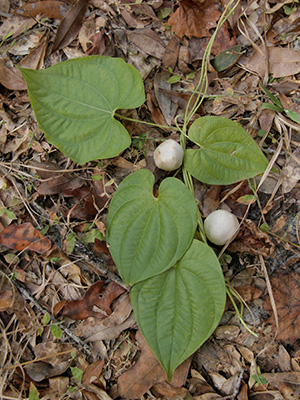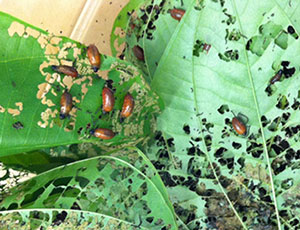Air Potato


Invasive exotic plants hurt ecosystems by displacing native plants and animals. Many, such as air potato, have been introduced as landscape plants and have gotten out of control. It is now illegal to plant air potato, but the plant spreads quickly on its own.
Air potato (Dioscorea bulbifera) is a vigorously twining vine, which grows from an underground tuber. The stems can rapidly grow to 60 feet in length. Air potato leaves are heart-shaped and can be up to eight inches long.
The plant forms hundreds of bulbils that look like potatoes (hence the common name), that drop to the ground and sprout more plants. Bulbils are round and light brown, with small nubs on them, and can range from the size of a pea to five inches across.
If you think your landscape contains air potato, contact your county Extension office for information about getting rid of the plant.
Air Potato Leaf Beetle

While many people know about the invasive air potato vine, few are aware of air potato leaf beetles. Native to Asia, these beetles feed and develop only on air potato plants, posing no risk to other plant species. Air potato leaf beetles are fairly large, about three-eighths of an inch long, and the mature beetles are an orange-red color. In 2012, air potato leaf beetles were released in Florida as a potential biological control of the aggressive air potato vine.
Air potato leaf beetles help in the fight against the air potato plant in a number of ways. Female beetles lay pale, white, oblong eggs on the undersides of young air potato leaves. This egg laying process deforms the expanding air potato leaves and causes the leaves to curl and cup.
Additionally, larvae feed on and skeletonize plant leaves from the underside. While the larvae prefer the younger, tender leaves, they will consume older leaves. Larvae are also able to feed on the aerial bulbils of the air potato plants, these aerial bulbs are the primary means of propagation for the plants. This feeding negatively affects the growth and reproduction of the plant.
The plant-specific feeding of this beetle was tested and verified by scientists at the USDA/ARS Invasive Plant Research Laboratory in Fort Lauderdale. Within three months of their release, extensive damage to air potato plants was observed at the initial release sites. The program ultimately resulted in the release of over a million beetles, which led to a 90 percent reduction of vine cover on native plant communities. Surveys conducted in 2015 and 2019 showed that the beetles were firmly established in their new domains.
